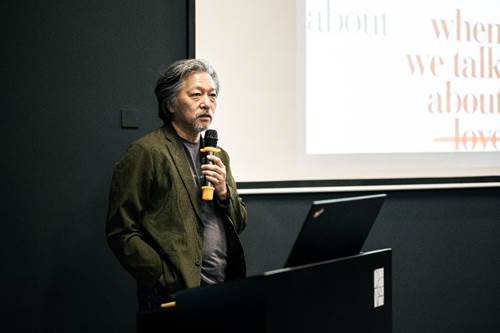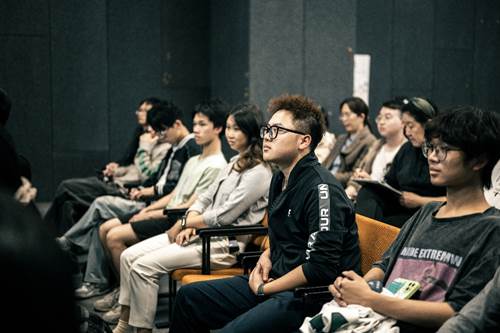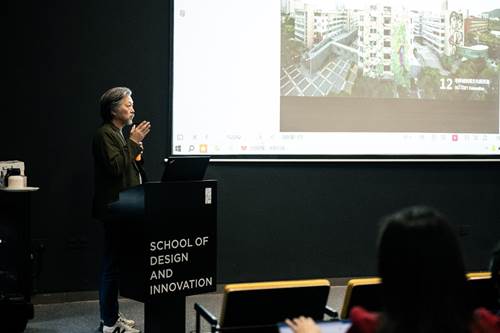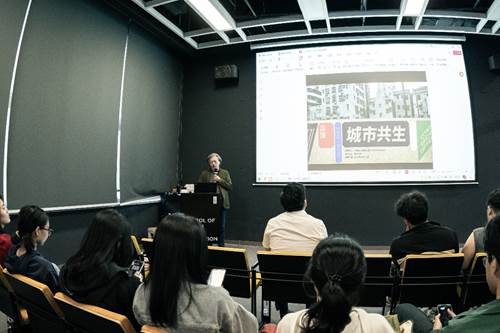Lecture Review | When we talk about architecture, what do we talk about
Author:School of Design and InnovationDate:2025.03.14
On March 22nd, Mr. Liu Xiaodu, the founding partner/chief designer of URBANUS Urban Practice Architectural Design Firm and the director of Pingshan Art Museum, was invited to visit the School of Design and Innovation at Shenzhen University of Technology. He gave a wonderful speech on the theme of "When We Talk about Architecture, What We Talk About" at the 420 "Spark Lecture Hall" of our institute.
Mr. Liu Xiaodu not only gave an in-depth introduction to URBANUS, one of the most influential independent architectural teams in China today, but also shared his unique insights and practical experience in urban planning and architectural design from six aspects: architecture, city, public, density, society, and research.


Mr. Liu Xiaodu, as one of the three founding partners of the Urban Practice Team, first introduced the team's background and development history to the teachers and students present. Since its establishment, the Urban Practice Team has been committed to exploring architectural and urban issues in modern urban life, contributing to the sustainable development of cities through innovative design concepts and practices. Urban practice is not only an institution, but also a philosophy. It aims to interpret the connotation of architecture from a broad urban perspective and specific urban experiences, closely following the reality of Chinese cities, and focusing on exploring the field of architecture based on the constantly emerging current urban problems. The work of urban practice is characterized by its sensitivity to the social and historical structure of cities, the integration of complex urban environments and potential spatial and social cultural resources, and the accurate identification of effective response strategies.
Next, Mr. Liu Xiaodu further elaborated on six aspects: architecture, urban development, public infrastructure, density, society, and research.

In terms of architecture, Mr. Liu Xiaodu emphasized the harmonious coexistence between architecture and urban environment. He mentioned that architecture is not only a spatial enclosure, but also a carrier of urban culture and a stage for people's lives. The urban practice team pays attention to the integration with the surrounding environment in the design, striving to create architectural works that are both unique and in line with the overall urban style.
In terms of cities, Mr. Liu Xiaodu pointed out that cities have the characteristics of virtuality, hybridity, and inclusiveness. Urban practice focuses on the current situation of Chinese cities, actively promoting research and practice on topics such as the protection and regeneration of historical districts and urban villages in old cities.
In the creation of public spaces, Mr. Liu Xiaodu seeks the meaning of the existence of places and emphasizes the openness and inclusiveness of public spaces. He believes that public space is an indispensable part of urban life, which not only promotes communication and interaction between people, but also enhances the vitality and charm of the city.
Regarding the issue of density, Mr. Liu Xiaodu stated that with the acceleration of urbanization, urban density continues to increase. How to achieve efficient, comfortable, and sustainable living in a limited space is a question that the urban practice team has been thinking about and exploring, focusing on the densely populated city of Shenzhen, where density is also a topic of urban practice.
At the societal level, Mr. Liu Xiaodu emphasized the impact of architecture and urban design on social development. He believes that excellent architecture and urban planning can promote social progress and improve people's quality of life. Society is also a city for people.
In addition, Mr. Liu Xiaodu also shared the team's research achievements and insights. He mentioned the "Urban Symbiosis" exhibition held in Nantou Ancient City in 2017, where more than 200 exhibitors from 25 countries explored and reflected on China's urban development model in the context of globalization through works that integrated architecture, art, and design, and attempted to depict the vision of future cities. Today's cities should be the result of a balanced diverse value system, a highly heterogeneous and differentiated civilization community where people live in the same world and hold different dreams. Cities should be harmonious and diverse, and their survival and prosperity lie in their ability to maximize tolerance and cultural identity towards "differences," "alternatives," and "others.


After the speech, teachers and students on site asked Mr. Liu Xiaodu questions and conducted in-depth discussions on practical issues and future trends in urban design. Mr. Liu Xiaodu patiently answered and shared his insights and experience with everyone.

Amidst warm applause, Mr. Liu Xiaodu took a group photo with the teachers and students present to commemorate the unforgettable speech event. This speech brought a feast of ideas for teachers and students, not only showcasing Mr. Liu Xiaodu's profound background and innovative spirit in the field of architecture and urban design, but also providing valuable learning and communication opportunities for teachers and students. I believe that the urban practice team will have more exciting stories blooming on the stage of urban planning and architectural design through exploration and thinking.

Photography | Xu Fuchai
Text | Ma Yue
Layout | Zhang Jiayan
Proofreading | Lin Zexuan
Review | Zhang Guijun